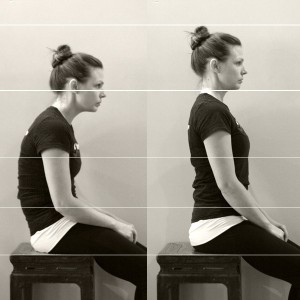 The four curves of the spine—sacral, lumbar, thoracic, and cervical—are supported by the position of the pelvis.
The four curves of the spine—sacral, lumbar, thoracic, and cervical—are supported by the position of the pelvis.
If the pelvis is in the correct position the spine can extend and its four curves can be maintained.
Unfortunately, most people go through life tucking the pelvis and throwing the alignment of the spine into disarray.
Tucking the pelvis leads to all sorts of dysfunction.
The thigh bones are pushed forward of the hips, the gluteal muscles activate constantly, and for this discussion, the lower back flattens or rounds backward throwing the rest of the spine out of whack.
The curve of the lumbar or lower spine bears and transfers the weight of the bones that lie above it and is essential for creating and maintaining the other vertebral curves.
As you can see in the picture above when tucking the pelvis the upper back moves backward and the head moves forward.
When the lumbar spine is curved in the correct position the spine extends up into its natural curves.
Kyphosis is the natural rounding of the back but when the pelvis is tucked under it puts more pressure on the upper spine often pushing it past its natural degree of curve.
There is a lot of core tone involved in maintaining these curves but tucking the pelvis disconnects our ability to access and activate the core muscles that we need for the support of the spine.
Nothing stops the march of time but skeletal alignment and muscular tone can go a long way to making the hike a much more pleasant one.
We must stop tucking the pelvis. It is pretty basic stuff. Stick your butt out a little. Get your legs under your hips. Find your lumbar curve.
Any of these things will prevent you from ending up with an excessively kyphotic upper back.
***
